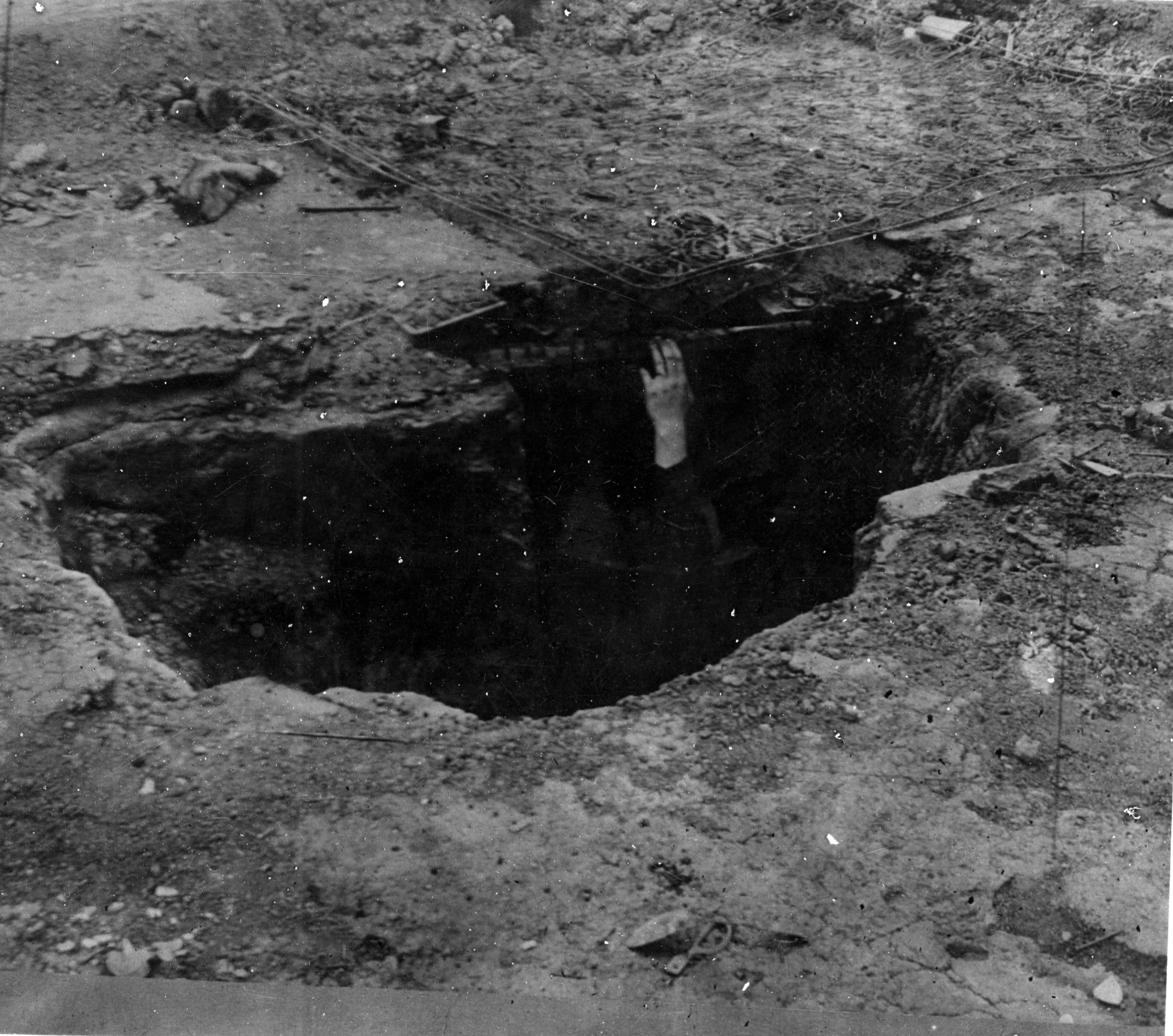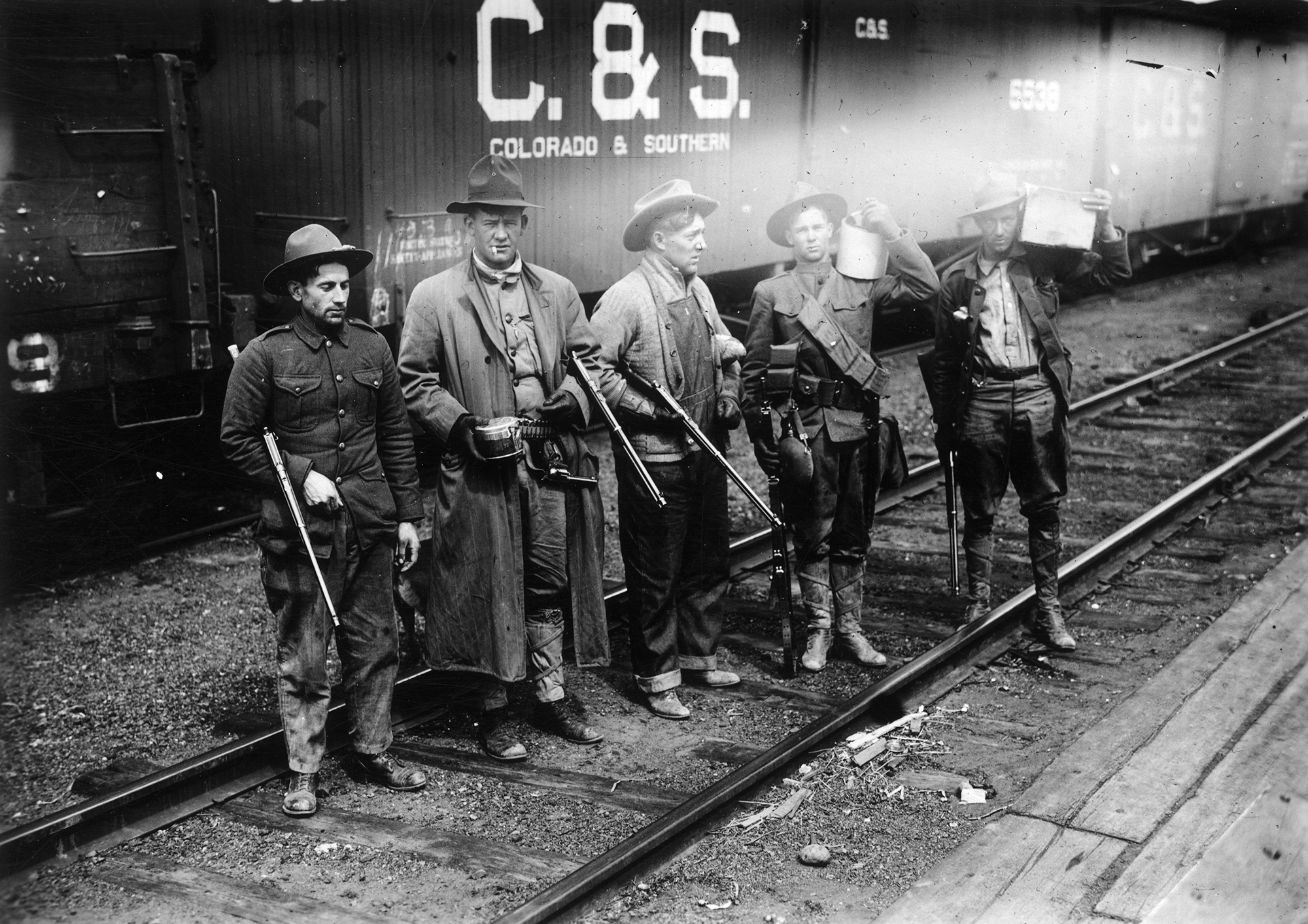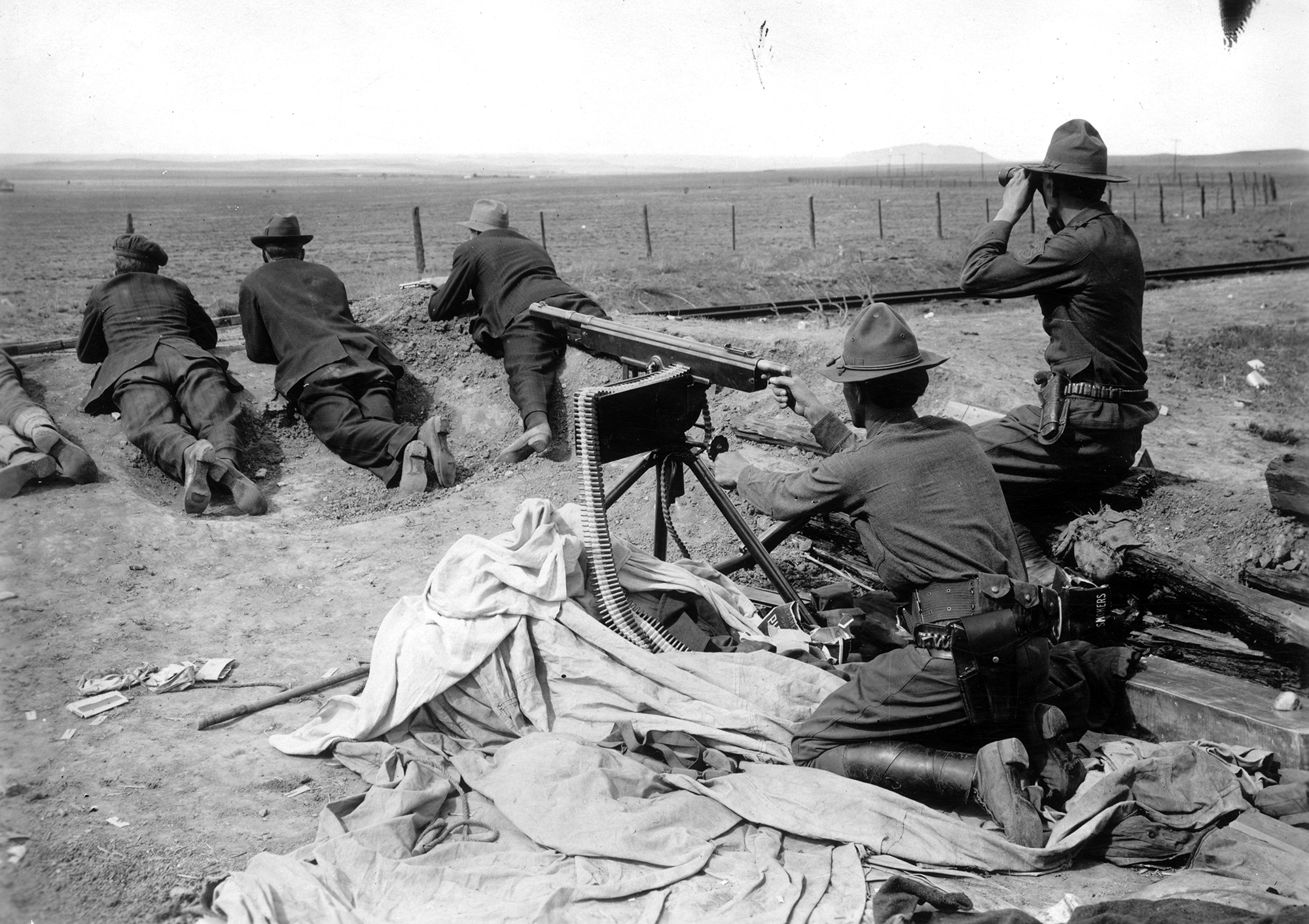
Story
The Mystery of the Hat in the Trunk
A Ludlow Massacre footnote reveals details about a photojournalist time forgot.
Stuart Aitkin Mace had long been mystified by a hat full of holes that he found in his father’s trunk in the attic of the family home in Denver. Being only four-and-a-half years old when his father, Stuart Garfield Mace, died in 1923—and having a mother who was “never much for telling the tough side of family history,” Stuart learned nothing about the hat until January 1951 when a “bouncing little guy” showed up at his Toklat Lodge residence in Ashcroft, a ghost town near Aspen where the younger Mace had established a sled dog business.
The man was Barron Beshoar, bureau chief for Time-Life and author of Out of the Depths, a biography of labor leader John R. Lawson who had been an organizer for the United Mine Workers of America in the Colorado coal fields. Beshoar spun a tale of working on his first scoop with Stuart’s dad at the Ludlow Massacre. Four decades later, Stuart recorded his memories of that vivid conversation. I sought out to discover if the tale was true and learn more about the man who may have worn that hat.

Stuart Garfield Mace’s photo of the “Death Pit,” where eleven children and two women were killed during the Ludlow Massacre.
From the start, Beshoar’s tale, retold by Stuart as part of an oral history in 1991, carries the hallmarks of a myth or a movie script. In 1914, so the story goes, The Denver Post sent photographer Stuart G. Mace and reporter Barron Beshoar to Ludlow to cover the events at the epicenter of the coal strike in southern Colorado shortly before fighting broke out between striking miners and militiamen. When the fighting began on April 20, Mace and Beshoar supposedly took shelter in a steel coal car from where they witnessed the militia attack on the strikers’ tent colony.
Mace had his ever-present bulky sodium flash camera (the black box) with him and tried to photograph the on-going battle. Realizing that he was a shooting duck target for the gunmen attacking the colony when he raised up to take a picture, Mace and Beshoar adopted a scheme reminiscent of scenes in many old western movies. They raised their hats above the side of the car to draw fire from the colony’s attackers. Using single-shot rifles, the gunmen, while reloading their weapons, gave Mace an opportunity between salvos of gunfire to jump up to take a picture. The number of holes in Mace’s hat indicated that the procedure was repeated several times.
When the rifle fire ceased and the militiamen stormed the camp to destroy the tents, Mace and Beshoar escaped and rushed to Denver with negatives in hand. Realizing there was incriminating photographic documentation of the attack on the tent colony, strikebreakers followed the two men to Denver. There they bribed the police to assist or stand by while they broke into The Denver Post offices and destroyed the Ludlow negatives as well as, for good measure, all of Mace’s lifetime work in the newspaper morgue (library). As a result of this action, there are no actual photographs of the militia attack on the colony.
In another taped interview with his daughter, Lynne, in February 1992, Stuart elaborated on this story. According to his account of his dad’s experiences, the Rockefellers—officials of the Rockefeller owned Colorado Fuel and Iron Corporation (CF&I), the largest and most powerful coal operator fighting the miners—felt compelled to take strong action against Mace and Beshoar for witnessing and documenting the militia attack on the Ludlow tent colony. They ordered the destruction of Mace’s Ludlow photographs, which, as physical evidence, they considered far more damaging to them than any newspaper article they could refute. They told Mace and Beshoar never to engage in such activity again and ordered them to remain silent about the whole affair. They threatened Beshoar with physical harm if he refused or if he continued to write damaging articles about the mine operators.
Frederick H. Bonfils and Harry H. Tammen, owners and publishers of The Denver Post, seized this opportunity to demand money from CF&I to keep the story quiet. These notoriously scheming blackmailers, however, met their equals in the Rockefellers, who demanded that the Post fire Mace and Beshoar at once or suffer severe consequences. Out blackmailed, Bonfils and Tammen conceded. To make things worse for Mace and Beshoar, CF&I instructed the Rocky Mountain News not to hire them and, believing pictures more threatening than words, stipulated that the same instruction not to hire him would follow Mace wherever he went.

Members of the Colorado National Guard pose for a photo taken by Stuart Garfield Mace.
But how much of this tale was true? The story, while compelling, was factually misleading in several important ways, with some details better suited for a movie script than a history book. For one thing, the Rocky Mountain News and the Denver Times, jointly owned by John C. Shaffer and operated from the same building, were the papers involved, rather than The Denver Post. Stuart G. Mace was the staff photographer for the Times and was not employed at the time by the Post. Additionally, Beshoar, a young boy of seven in 1914, could not have been the reporter sent to the strike zone to accompany Mace. Nor was he in the coal car with him during the battle of Ludlow.
Although obscured by discrepancies, the story of the hat does provide a major clue to what happened to the Denver Times’s staff photographer in the wake of the Ludlow Massacre. Beshoar established that something happened to Mace, but it had nothing to do with Bonfils or Tammen and the Denver Post. Instead, it was Mace trapped in CF&I’s retaliatory action against the Rocky Mountain News and the Denver Times for condemning the coal operators and the governor for the “Massacre of the Innocents” at Ludlow.
Stuart Garfield Mace was one of the most widely known and highly respected newspaper photographers in Denver and the West during the early twentieth century. With his charm and good nature, he obtained photographs of celebrities that no other newspaper could get, including the future Duke of Windsor. As staff photographer for the Denver Times, he helped make newspaper history not only by taking photographs of celebrities, but also by memorializing the constantly changing social and political dynamics of the local world. He was one of the founding members of the Denver Press Club.
Mace was on assignment for the Times at Ludlow in April 1914. He had arrived there in time to photograph the militia activities in preparation for the attack on the strikers’ tent colony. From the photographs he produced, it appears the militia gave him complete freedom to present to the public a photographic record of its presence in the field. It seemed neither the militia nor the coal operators and their allies objected to these images. The militia, in fact, were all too happy to use them for propaganda purposes. Unlike Lou Dold, a freelance photographer sympathetic to the union, whose photographs told the story of the strikers and their families, Mace concentrated on the military side of the conflict. Combined, the complementary work of the two men produced some of the most important historical documentation of the deadliest labor war in American history.
Following the Ludlow Massacre, Mace remained in the strike zone until at least the end of April. Under the supervision of the militia, he joined other photographers, reporters, and philanthropic workers on April 22 to inspect the destroyed Ludlow camp. While there, he captured on film militiamen standing guard among the ruins and a militiaman raising his hand to measure the depth of the Black (Death) Hole where two women and eleven children died during the militia attack. He continued in the days following to photograph scenes of the war zone during the Ten Days War. The April 25 issue of the Denver Times featured a full-page collection of his photos taken during this time.
Events in Denver, while Mace was still in the field, changed his life forever. On April 22, the Rocky Mountain News published editorial editor William Chenery’s explosive screed entitled “Massacre of the Innocents.” Governor Elias Ammons, Chenery boldly asserted, was a lackey of the coal barons who led a private war against miners at Ludlow financed by John D. Rockefeller, “the richest man in the world.” The Denver Chamber of Commerce’s reaction to the editorial was immediate. A committee representing the leaders of the organization rushed to the News offices and threatened to impose an advertising boycott unless Chenery was silenced and Harvey Deuell, the News correspondent whose articles set up Chenery’s editorial, was transferred to another assignment. CF&I’s vendetta against Deuell suggests that he might have been the reporter who was with Mace at Ludlow during the attack on the tent colony.
Undaunted, Chenery stood his ground and vowed to continue to publish the truth about the governor’s and coal operators’ activities and policies. He specifically heaped scorn on the Rockefeller owned CF&I, declaring that the company’s officials could never intimidate the News as they had the governor. CF&I answered by filing a $500,000 libel suit against the News and Denver Times, but CF&I abandoned both the boycott effort and the libel suit when the Denver Post defended its newspaper competitors in the name of freedom of the press.
The Post’s intervention was irrelevant, however. CF&I had already accomplished its objective. Deeply sensitive to the severe criticism Chenery’s editorials had provoked, Gene Fowler of the News reported, John C. Shaffer ended his paper’s “crusading spirit” on behalf of the “little people.” The reversal demoralized the News staff. Chenery left to become editor of Collier’s Weekly. Other editors and reporters departed as well, including Fowler. Deuell continued to write for the News and Times, but eventually moved on to become managing editor for the New York Daily News. For all practical purposes, the leadership of CF&I had intimidated Shaffer’s papers back to a position more to their liking.
A closer analysis of the matter reveals that Chenery and Deuell were not the only CF&I targets. Stuart G. Mace was also caught in the corporation’s retaliatory action against anyone involved in the News and Times coverage of the strike activities. To make their point more forcibly after the Times ended its relationship with him, CF&I blacklisted him from gaining employment with any Denver newspaper in the future. Thus, CF&I’s action altered the careers of Chenery and Mace: the former lost his job with the News and the latter not only lost his job, but was banished from the newspaper business as a photojournalist essentially for the rest of his life.

Colorado National Guard members used automatic weapons to suppress the United Mine Workers strike.
The tragedy of the last years of Stuart G. Mace’s life was portrayed mostly by information found in a scrapbook and from family history. Following his forced exile as a photojournalist, Mace opened a commercial photography business. Although it was described in an obituary as a successful business, he remained on the edge of financial ruin. He had opportunities to become a cameraman for motion pictures, but, frail and in poor health, he chose to stay in Denver with his wife and young son. He suffered from severe depression. Emphysema from inhaling the poisonous vapors of the “closet”—the dark room—from which he had worked for the Denver Times contributed to his failing health, as did poor eyesight that left him totally blind shortly before his death.
In spite of his poor health, he finally gained employment in 1920 as a staff photographer for The Denver Post. A fortuitous opportunity for him occurred when he spotted John D. Rockefeller, Jr. and his three sons at the base of a statue at the state Capitol on the last day of their Colorado vacation. He snapped a picture of them that was published in the Post on June 22. It was the first photograph of the Rockefeller sons taken by a newspaper photographer with the permission of their father.
The photograph must have caught the attention of someone in the CF&I office, for the Post terminated Mace’s contract on the same day the photograph was published. Mace appealed to Rockefeller immediately. He pleaded his case and promised not to engage in any negative activity against CF&I. Rockefeller’s response arrived a few days later on June 29. “I am much disturbed at what you say in regard to your position with The Denver Post,” he wrote. “It must be that the managing editor has not thoroughly understood the situation. I am taking steps to try to have this matter properly laid before your superiors and trust there may be a reversal of the notice given to you. You were so fair and honorable with me that I shall be only too glad to do anything I can to help you in this situation.”
Evidently the ban was lifted. Mace took his camera to the streets of Denver again to snap pictures of burned-out trolley cars and federal troops during the trolley strike in August, 1920. But failing health was now his greatest enemy. His attempt to return to his profession was interrupted when he suffered a nervous breakdown in 1921 that confined him to his bed for eight months. Even though his health remained precarious, he recovered enough to resume some of his work before contracting pneumonia in July, 1923. Although he seemed to be gradually recovering, he died suddenly of a brain aneurysm five weeks later on September 21. He was forty-two.
His son, Stuart, never pressed his mother for information about his father. The subject was too painful for her to discuss. He did ask her about the hat full of holes that he found in his father’s trunk, but even this was something that she would not address. It was also too painful for his uncles, Gordon and Charles Mace, although “Uncle Charlie” told his nephew he would never go into the newspaper business because of what “they” did to his father. For them, the affair was a tragedy of the first order that totally destroyed their brother.
The mysterious hat in the trunk symbolized the life of a man whose ingratiating personality and disregard of danger and hardship allowed him to produce photographs that represented the best in American newspaper photography. The story of the hat in the trunk is also a reminder of how CF&I officials and their coal operator and Chamber of Commerce allies tried to erase the Ludlow Massacre from history. History, however, through the voices of recent scholars, refuses to remain silent.
Sources: The primary sources for this article are two taped recordings made in 1991 and 1992 by the late Stuart A. Mace of Toklat, Ashcroft. In the recordings, Mace relates the story of what Barron Beshoar told him about the experience of his father, Stuart G. Mace, staff photographer for the Denver Times, during the Ludlow Massacre and its aftermath. Although Beshoar’s account and Mace’s interpretation of it are historically incorrect in many respects, both uncover an incident never before published. Two newspaper articles provide verification of the account: “John D. Jr. Surrenders to Camera, Admits He Is a Public News Item,” The Denver Post, June 22, 1920, and “Toklat Husky Teams to Be in ‘Life’ Soon,” The Aspen Daily Times, January 11, 1951. Additional sources consulted put the account in historical perspective: Gene Fowler, A Solo in Tom-Toms (New York: The Viking Press, 1946), and F. Darrell Munsell, From Redstone to Ludlow: John Cleveland Osgood’s Struggle against the United Mine Workers of America (Boulder, CO: University Press of Colorado, 2009). The Mace family scrapbook included obituaries and other important family information about Stuart G. Mace. It also yielded John D. Rockefeller, Jr.’s June 29, 1920, letter, which shed light on what happened to Mace.
